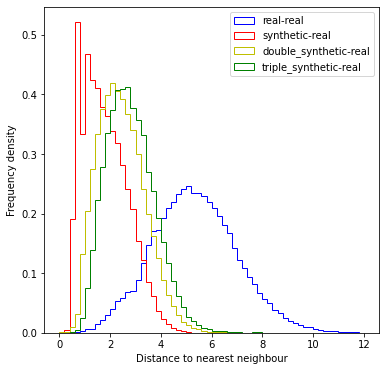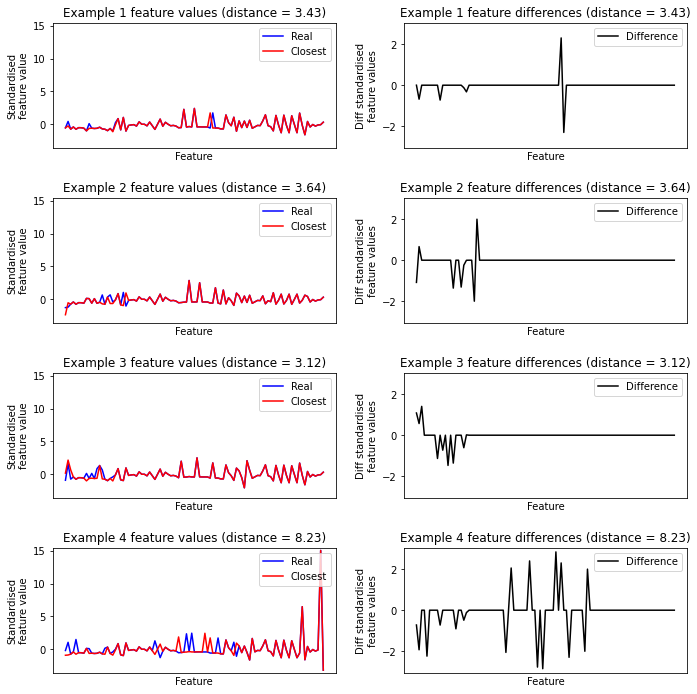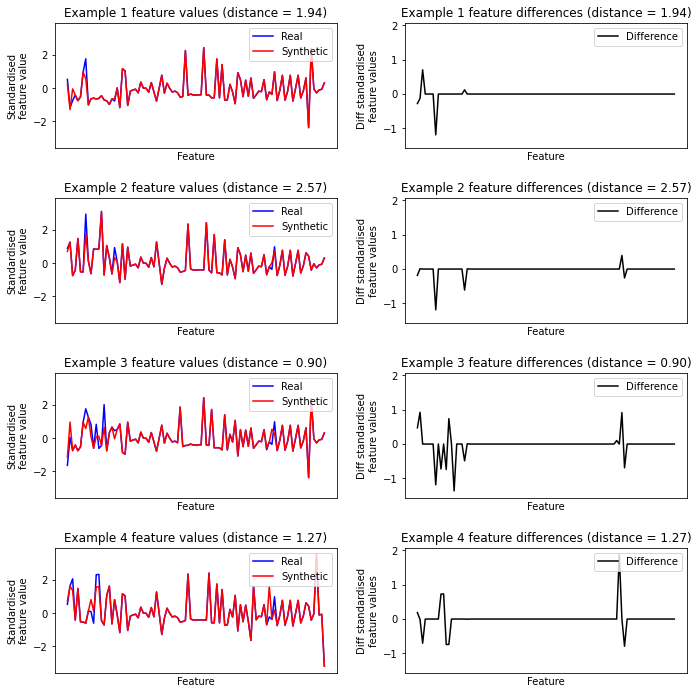Testing of SAMueL-1 synthetic data: Compare differences between synthetic data and real data nearest-neighbours
Contents
Testing of SAMueL-1 synthetic data: Compare differences between synthetic data and real data nearest-neighbours#
This notebook shows some examples of synthetic data alongside the nearest-neighbour real data used to create the synthetic data, and show the distribution of distances between real data point nearest neighbours and nearest neighbour distances between synthetic and real data points. Distance between real and synthetic data is measured as Cartesian distance between standardised data for admissions to the same stroke unit.
We look at synthetic data produced directly from real data, ‘double synthetic’ data - which is data produced from the first round of synthetic data, and ‘triple synthetic’ data - which is data produced from the double synthetic data.
Load packages#
import matplotlib.pyplot as plt
import numpy as np
import pandas as pd
from sklearn.preprocessing import StandardScaler
from sklearn.neighbors import NearestNeighbors
# Turn warnings off to keep notebook clean
import warnings
warnings.filterwarnings("ignore")
Load data#
data_loc = './../data/sam_1/kfold_5fold/'
train = pd.read_csv(data_loc + 'train_0.csv')
test = pd.read_csv(data_loc + 'test_0.csv')
synthetic = pd.read_csv(data_loc + 'synthetic_0.csv')
synthetic_double = pd.read_csv(data_loc + 'synthetic_double_0.csv')
synthetic_triple = pd.read_csv(data_loc + 'synthetic_triple_0.csv')
X_train = train.drop('S2Thrombolysis', axis=1)
X_test = test.drop('S2Thrombolysis', axis=1)
X_synthetic = synthetic.drop('S2Thrombolysis', axis=1)
X_synthetic_double = synthetic_double.drop('S2Thrombolysis', axis=1)
X_synthetic_triple = synthetic_triple.drop('S2Thrombolysis', axis=1)
Functions#
Function to standardise data#
def standardise_data(X_train, X_test):
# Initialise a new scaling object for normalising input data
sc = StandardScaler()
# Set up the scaler just on the training set
sc.fit(X_train)
# Apply the scaler to the training and test sets
train_std = sc.transform(X_train)
test_std = sc.transform(X_test)
return train_std, test_std
Function to find closest data points#
def find_distance_to_closest_real_data(X_actual, X_synthetic):
"""
Find nearest neighbour in the real data set (based on Cartesian distance of
standardised data).
"""
# Standardise data (based on real training data)
X_actual_std, X_synth_std = standardise_data(
X_actual, X_synthetic)
# Use ScitLearn neighbors.NearestNeighbors to get nearest neighbour
nn = NearestNeighbors(n_neighbors=1, algorithm='auto').fit(X_actual_std)
dists, idxs = nn.kneighbors(X_synth_std)
# Convert row idxs to index in original index in X_actual
real_ids = list(X_actual.iloc[idxs.flatten()].index)
# Store in dictionary
nearest_neighbours = dict()
nearest_neighbours['distances'] = list(dists.flatten())
nearest_neighbours['ids'] = real_ids
return nearest_neighbours
Get closest distances between real data points, and between synthetic and real data#
Standardise real (X_train) data and set up nearest neighbour algorithm#
X_actual_std, X_actual_std = standardise_data(
X_train.drop('StrokeTeam', axis=1),
X_train.drop('StrokeTeam', axis=1))
nn = NearestNeighbors(n_neighbors=1, algorithm='auto').fit(X_actual_std)
Get nearest neighbours in real data#
# Get closest neighbours in real data
dists, idxs = nn.kneighbors()
dist_real_real = dists.flatten()
indx_real_real = idxs.flatten()
Get nearest neighbours between synthetic data and real data#
(Using synthetic data produced directly from real data).
# Get closest neighbours between synthetic and real data
X_actual_std, X_synthetic_std = standardise_data(
X_train.drop('StrokeTeam', axis=1),
X_synthetic.drop('StrokeTeam', axis=1))
dists, idxs = nn.kneighbors(X_synthetic_std)
dist_synthetic_real = dists.flatten()
indx_synthetic_real = idxs.flatten()
Get nearest neighbours between double synthetic data and real data#
(Using synthetic data produced from synthetic data).
# Get closest neighbours between double synthetic and real data
X_actual_std, X_synthetic_double_std = standardise_data(
X_train.drop('StrokeTeam', axis=1),
X_synthetic_double.drop('StrokeTeam', axis=1))
dists, idxs = nn.kneighbors(X_synthetic_double_std)
dist_synthetic_double_real = dists.flatten()
indx_synthetic_double_real = idxs.flatten()
Get nearest neighbours between triple synthetic data and real data#
(Using synthetic data produced from double synthetic data).
# Get closest neighbours between triple synthetic and real data
X_actual_std, X_synthetic_triple_std = standardise_data(
X_train.drop('StrokeTeam', axis=1),
X_synthetic_triple.drop('StrokeTeam', axis=1))
dists, idxs = nn.kneighbors(X_synthetic_triple_std)
dist_synthetic_triple_real = dists.flatten()
indx_synthetic_triple_real = idxs.flatten()
Plot histogram of distances to nearest real data point#
bins = np.arange(0, 12.1, 0.2)
fig = plt.figure(figsize=(6, 6))
ax = fig.add_subplot(111)
ax.hist(dist_real_real, bins=bins, histtype='step', color='b',
density=True, label='real-real')
ax.hist(dist_synthetic_real, bins=bins, histtype='step', color='r',
density=True, label='synthetic-real')
ax.hist(dist_synthetic_double_real, bins=bins, histtype='step', color='y',
density=True, label='double_synthetic-real')
ax.hist(dist_synthetic_triple_real, bins=bins, histtype='step', color='g',
density=True, label='triple_synthetic-real')
ax.set_xlabel('Distance to nearest neighbour')
ax.set_ylabel('Frequency density')
ax.legend()
plt.savefig('./images/distance_comparison.png', dpi=300)
plt.show()

Summary statistics of distances to nearest real data point#
statistics = pd.DataFrame()
statistics['Real-Real'] = pd.DataFrame(dist_real_real).describe()
statistics['Synthetic-Real'] = pd.DataFrame(dist_synthetic_real).describe()
statistics['Double synthetic-Real'] = \
pd.DataFrame(dist_synthetic_double_real).describe()
statistics['Triple synthetic-Real'] = \
pd.DataFrame(dist_synthetic_triple_real).describe()
statistics
| Real-Real | Synthetic-Real | Double synthetic-Real | Triple synthetic-Real | |
|---|---|---|---|---|
| count | 71142.000000 | 71142.000000 | 71142.000000 | 71142.000000 |
| mean | 5.337489 | 1.800324 | 2.439078 | 2.795586 |
| std | 1.680298 | 0.883151 | 0.931313 | 0.955745 |
| min | 0.000000 | 0.112121 | 0.021724 | 0.455704 |
| 25% | 4.186705 | 1.078850 | 1.740018 | 2.090752 |
| 50% | 5.274546 | 1.677866 | 2.356923 | 2.707960 |
| 75% | 6.417106 | 2.398763 | 3.038597 | 3.399680 |
| max | 44.942009 | 15.336283 | 22.257794 | 16.605757 |
Show proportion of points that are identical to real data#
# Count identical points between real and synthetic data
identical = np.mean(dist_synthetic_real < 0.001)
print(
f'Proportion identical between real and synthetic data: {identical:0.3f}')
# Count identical points between real and double synthetic data
identical = np.mean(dist_synthetic_double_real < 0.001)
print(
f'Proportion identical between real and double synthetic data: {identical:0.3f}')
Proportion identical between real and synthetic data: 0.000
Proportion identical between real and double synthetic data: 0.000
Show near neighbour examples between real data#
# Sample 4 real data points
np.random.RandomState=42
sample_index = np.random.choice(np.arange(len(X_train)), 4)
real_samples_a = X_train.iloc[sample_index]
closest_neigbour_index = indx_real_real[sample_index]
real_samples_b = X_train.iloc[closest_neigbour_index]
real_sample_differences = dist_real_real[sample_index]
# Save
real_samples_a.to_csv('./synth_examples/real_samples_a.csv')
real_samples_b.to_csv('./synth_examples/real_samples_a_nn.csv')
# Standardise
cols = list(X_train.drop('StrokeTeam', axis=1))
X_train_std, real_samples_a_std = standardise_data(
X_train[cols], real_samples_a[cols])
X_train_std, real_samples_b_std = standardise_data(
X_train[cols], real_samples_b[cols])
# Get axis limits
value_min = min(np.min(real_samples_a_std), np.min(real_samples_b_std)) - 0.4
value_max = max(np.max(real_samples_a_std), np.max(real_samples_b_std)) + 0.4
diff = real_samples_b_std - real_samples_a_std
diff_min = np.min(diff) - 0.2
diff_max = np.max(diff) + 0.2
fig, ax = plt.subplots(4, 2, figsize=(10, 10))
ax = ax.ravel()
for i in range(4):
row = i
y1 = real_samples_a_std[i]
y2 = real_samples_b_std[i]
x = range(len(y1))
ax[row * 2].plot(x, y1, color='b', label='Real')
ax[row * 2].plot(x, y2, color='r', linestyle='-', label='Closest')
ax[row * 2].get_xaxis().set_ticks([])
ax[row * 2].set_xlabel('Feature')
ax[row * 2].set_ylabel('Standardised\nfeature value')
ax[row * 2].set_ylim(value_min, value_max)
distance = real_sample_differences[i]
title = f'Example {i + 1} feature values (distance = {distance:0.2f})'
ax[row * 2].set_title(title)
ax[row * 2].legend(loc='upper right')
y = y = real_samples_b_std[i] - real_samples_a_std[i]
x = range(len(y1))
ax[row * 2 + 1].plot(x, y, color='k', label='Difference')
ax[row * 2 + 1].get_xaxis().set_ticks([])
ax[row * 2 + 1].set_xlabel('Feature')
ax[row * 2 + 1].set_ylabel('Diff standardised\nfeature values')
ax[row * 2 + 1].set_ylim(diff_min, diff_max)
title = f'Example {i + 1} feature differences (distance = {distance:0.2f})'
ax[row * 2 + 1].set_title(title)
ax[row * 2 + 1].legend(loc='upper right')
plt.tight_layout(pad=2)
fig.patch.set_facecolor('w')
plt.savefig('./images/nn_examples_real_to_real.png', dpi=300)
plt.show()

Show near neighbour examples between (double) synthetic data and real data#
Double synthetic data removes the peak of instances that are in close proximity to real data, so we will proceed woth double-synthetic data.
# Sample 4 double synthetic data points
np.random.RandomState=42
sample_index = np.random.choice(np.arange(len(X_synthetic_double)), 4)
synth_examples = X_synthetic_double.iloc[sample_index]
closest_neigbour_index = indx_synthetic_double_real[sample_index]
real_examples = X_train.iloc[closest_neigbour_index]
real_synthetic_differences = dist_synthetic_double_real[sample_index]
# Save
synth_examples.to_csv('./synth_examples/synth_examples.csv')
real_examples.to_csv('./synth_examples/closest_real.csv')
# Standardise
cols = list(X_train.drop('StrokeTeam', axis=1))
X_train_std, real_examples_std = standardise_data(
X_train[cols], real_examples[cols])
X_train_std, synth_examples_std = standardise_data(
X_train[cols], synth_examples[cols])
# Get axis limits
value_min = min(np.min(real_examples_std), np.min(synth_examples_std)) - 0.4
value_max = max(np.max(real_examples_std), np.max(synth_examples_std)) + 0.4
diff = synth_examples_std - real_examples_std
diff_min = np.min(diff) - 0.2
diff_max = np.max(diff) + 0.2
fig, ax = plt.subplots(4, 2, figsize=(10, 10))
ax = ax.ravel()
for i in range(4):
row = i
y1 = real_examples_std[i]
y2 = synth_examples_std[i]
x = range(len(y1))
ax[row * 2].plot(x, y1, color='b', label='Real')
ax[row * 2].plot(x, y2, color='r', linestyle='-', label='Synthetic')
ax[row * 2].get_xaxis().set_ticks([])
ax[row * 2].set_xlabel('Feature')
ax[row * 2].set_ylabel('Standardised\nfeature value')
ax[row * 2].set_ylim(value_min, value_max)
distance = dist_synthetic_double_real[i]
title = f'Example {i + 1} feature values (distance = {distance:0.2f})'
ax[row * 2].set_title(title)
ax[row * 2].legend(loc='upper right')
y = synth_examples_std[i] - real_examples_std[i]
x = range(len(y1))
ax[row * 2 + 1].plot(x, y, color='k', label='Difference')
ax[row * 2 + 1].get_xaxis().set_ticks([])
ax[row * 2 + 1].set_xlabel('Feature')
ax[row * 2 + 1].set_ylabel('Diff standardised\nfeature values')
ax[row * 2 + 1].set_ylim(diff_min, diff_max)
title = f'Example {i + 1} feature differences (distance = {distance:0.2f})'
ax[row * 2 + 1].set_title(title)
ax[row * 2 + 1].legend(loc='upper right')
plt.tight_layout(pad=2)
fig.patch.set_facecolor('w')
plt.savefig('./images/nn_examples.png', dpi=300)
plt.show()

Observations#
The nearest neighbour distance between synthetic and real data points is generally smaller than the nearest neighbour distance between real data points.
The use of double synthetic data avoids a peak of synthetic data that has close proximity to real data.
There are no identical points in the real data or between real and synthetic data (of either type).